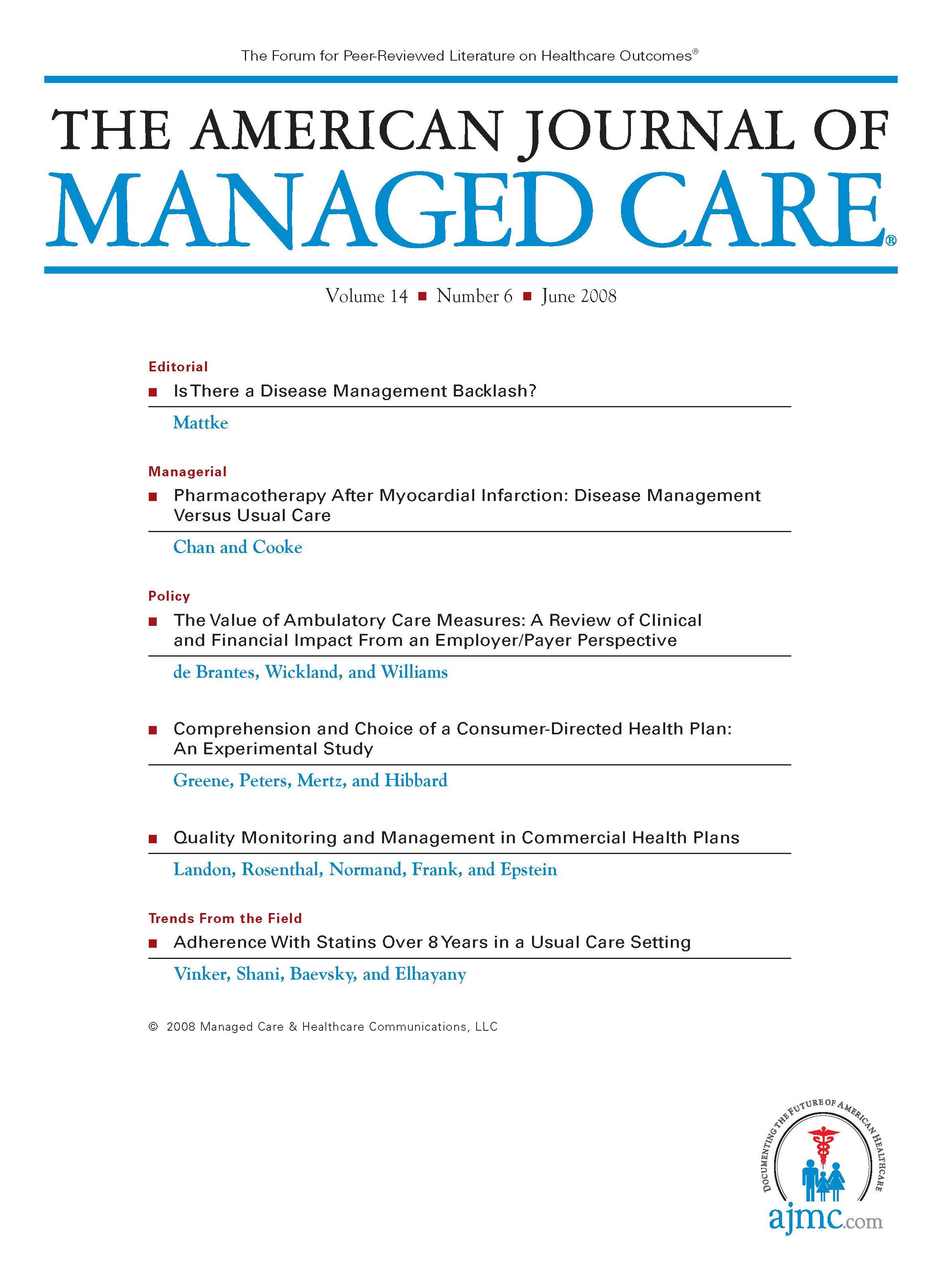- Center on Health Equity & Access
- Clinical
- Health Care Cost
- Health Care Delivery
- Insurance
- Policy
- Technology
- Value-Based Care
The Importance of Recognizing Patients' Time as a Cost of Self-Management
TO THE EDITORS
:Self-management of chronic disease is crucial for optimal health. In the March 2008 issue, Tunis and Minshall evaluated the cost-effectiveness of self-monitoring of blood glucose (SMBG) in patients with type 2 diabetes on oral diabetes medicines.1 They concluded that self-monitoring is a good value, with costs per quality-adjusted life-year (QALY) below $30,000 even over horizons as short as 5 years.
Patients’ time is essential for medical care, especially self-management. The Panel on Cost-Effectiveness in Health and Medicine recommended that patients’ time be recognized as a cost in cost-effectiveness analysis,2 but it rarely is and Tunis and Minshall did not include it. Often the stated reason is lack of data, but a published estimate of the time required for SMBG, made by a group of diabetes educators, is available: 3 minutes per monitoring episode for experienced patients with type 2 diabetes controlled by oral agents,3 likely a conservative estimate for Tunis and Minshall’s “new users.” Three minutes does not sound like much, but repeated daily for a year it amounts to 18.25 hours, which, valued at the average 2006 hourly wage in private nonagricultural industry ($16.76),4 is $306 per patient per year. Self-monitoring 3 times daily requires time worth $918 per patient per year.
Table
Figure 7
We used these values to recalculate the incremental cost-effectiveness ratios Tunis and Minshall reported for their 3 time horizons: 40 years/lifetime, 5 years, and 10 years (see the ). We used the same 3% discount rate and conservatively assumed that 95% of the remaining cohort survived each year, a rate consistent with the validation of the CORE model used by Palmer et al in Figure 7 of their article.5()
The incremental cost-effectiveness ratios are much higher when patients’ time is included. The increases are greatest for the shorter time horizons that may be of most interest to providers. For example, Tunis and Minshall estimated that, over a 5-year horizon, self-monitoring once daily would cost $23,380 per QALY gained. When patients’ time is included, that cost rises to $76,340 per QALY gained.
Some may think the average wage is not appropriate for these patients, many of whom are retired, but retired people still value their time and have other uses for it. The average wage allows us to gain an appreciation for the magnitude of patients’ time relative to the other resources required for self-monitoring. How individual patients respond to the time required will depend on their own valuation of their time; some may value it less highly than the average wage, others more highly. Note that the time valuation does not include the effort required to schedule being near the SMBG equipment at the right times, especially important when patients test 3 times daily.
We suggest that providers may want to consider the time requirements of self-management activities to better understand when and why patients follow their advice, and when and why they do not. Time is very much a cost to patients and influences their willingness and ability to comply with self-management recommendations with the regularity required to achieve the best results. The recalculated results show that it is a substantial cost.
Louise B. Russell, PhDInstitute for Health, Health Care Policy, & Aging Research
New Brunswick, New Jersey
Monika M. Safford, MD
University of Alabama at Birmingham
1.Tunis SL, Minshall ME. Self-monitoring of blood glucose in type 2 diabetes: cost-effectiveness in the United States. Am J Manag Care. 2008;14(3):131-140.
3. Russell LB, Suh D-C, Safford MM.Time requirements for diabetes self-management: too much for many? J Fam Pract. 2005;54(1):52-56.
5. Palmer AJ, Roze S,Valentine WJ, et al. Validation of the CORE diabetes model against epidemiological and clinical studies. Curr Med Res Opin. 2004;20(suppl 1):S27-S40.
IN REPLY:
Health Economics and Outcomes Research
Noblesville, IN
Funding: LifeScan, A Johnson and Johnson Company.
Author Disclosures: The authors (SLT, MEM) are employees of IMS, a company that provides contracted research consulting to LifeScan.
Address correspondence to: Sandra L. Tunis, PhD, Health Economics and Outcomes Research, IMS Consulting Services, 14701 Cumberland Rd, Ste 107, Nobelsville, IN 46060. E-mail: stunis@us.imshealth.com.
References1.Tunis SL, Minshall ME. Self-monitoring of blood glucose in type 2 diabetes: cost-effectiveness in the United States. Am J Manag Care. 2008;14(3):131-140.
3. Centers for Disease Control and Prevention, National Center for Health Statistics. National Nutrition and Health Examination Survey (NHANES) data. Hyattsville, MD: US Department of Health and Human Services; 2000.

Trends in Hospital Pricing for Vulnerable Emergency Department Users, 2021-2023
December 4th 2025Self-pay emergency department prices rose significantly from 2021 to 2023, especially at for-profit and system-affiliated hospitals, highlighting growing affordability challenges for uninsured and underinsured patients.
Read More
Integrated Care for Chronic Conditions: A Randomized Care Management Trial
December 3rd 2025The authors sought to understand the differential impact of payer-led community-based care management approaches on stakeholder-oriented outcomes for publicly insured adults with multiple chronic conditions.
Read More

